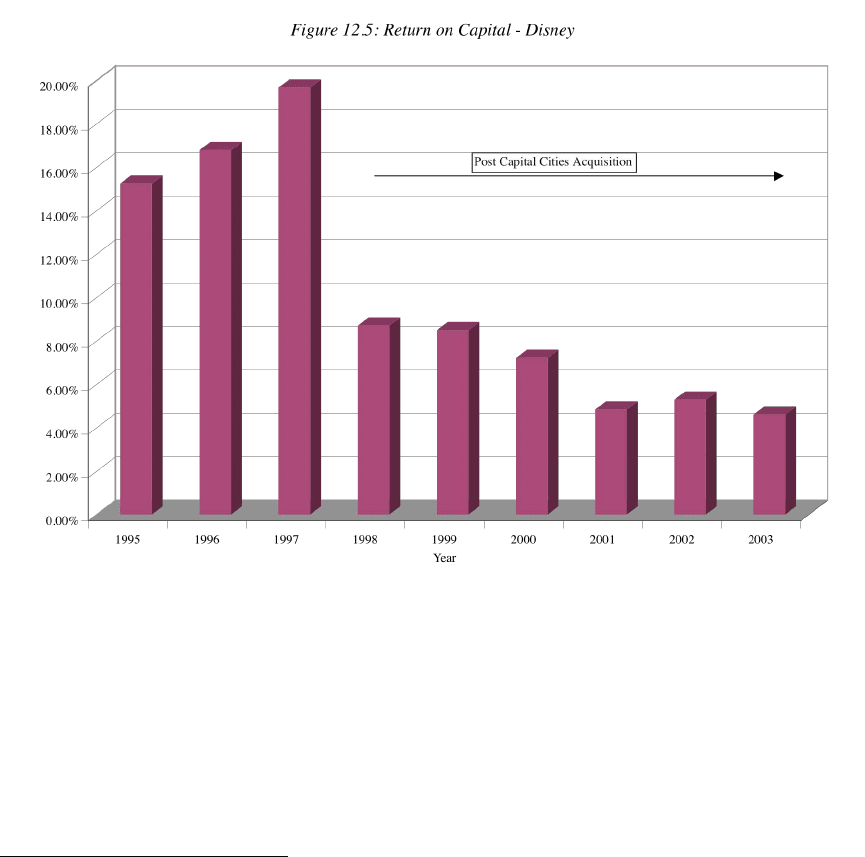Damodaran A. Applied corporate finance
Подождите немного. Документ загружается.


37
37
• The first adjustment is for financing expenses that accountants treat as operating
expenses. The most significant example is operating leases. Since these lease
payments constitute firm commitments into the future, they are tax deductible, and
the failure to make lease payments can result in bankruptcy, we treat these expenses
as financial expenses. The adjustment, which we describe in detail in chapter 4,
results in an increase in both the operating income and the debt outstanding at the
firm.
• The second adjustment is to correct for the incidence of one-time or irregular income
and expenses. Any expense (or income) that is truly a one-time expense (or income)
should be removed from the operating income and should not be used in forecasting
future operating income. While this would seem to indicate that all extraordinary
charges should be expunged from operating income, there are some extraordinary
charges that seem to occur at regular intervals – say once every four or five years.
Such expenses should be viewed as “irregular” rather than extraordinary expenses
and should be built into forecasts. The easiest way to do this is to annualize the
expense. Put simply, this would mean taking one-fifth of any expense that occurs
once every five years, and computing the income based on this apportioned expense.
As for the tax rate, the effective tax rates reported by most firms are much lower than the
marginal tax rates. As with the operating income, we should look at the reasons for the
difference and see if these firms can maintain their lower tax rates. If they cannot, it is
prudent to shift to marginal tax rates in computing future after-tax operating income.
Illustration 12.6: Estimating Growth Rate in Operating Income - Disney
We begin by estimating the reinvestment rate and return on capital for Disney in
2003, using the numbers from the latest financial statements. We did convert operating
leases into debt and adjusted the operating income and capital expenditure accordingly.
19
Reinvestment Rate
2003
= (Cap Ex – Depreciation + Chg in non-cash WC)/ EBIT (1-t)
19
The book value of debt is augmented by the $1,753 million in present value of operating lease
commitments. The unadjusted operating income for Disney was $2,713 million. The operating lease
adjustment adds the inputed interest expense on the PV of operating leases to the operating income (5.25%
of $1753 million= $92 million), the current year’s operating lease expense to capital expenditures ($556
million) and the depreciation on the leased asset to depreciation ($195 million).

38
38
= (1735 – 1253 + 454)/(2805(1-.373)) = 53.18%
Return on capital
2003
= EBIT (1-t)
2003
/ (BV of Debt
2002
+ BV of Equity
2002
)
= 2805 (1-.373)/ (15,883+23,879) = 4.42%
If Disney maintains its 2003 reinvestment rate and return on capital for the next few
years, its growth rate will be only 2.35%.
Expected Growth Rate from existing fundamentals = 53.18% * 4.42% = 2.35%
To make our estimates for the future, we look at Disney’s returns on capital and
reinvestment rates from 1995 to 2003 in Figure 12.5:
Note the dramatic drop in the return on capital after the Capital Cities acquisition from
more than 19% in 1997 to less than 10% in 1998.
20
While this may sound optimistic, we
will assume that Disney will be able to earn a return on capital of 12% on its new
investments and that the reinvestment rate will be 60% for the immediate future.
21
The
expected growth in operating income over this period will be 7.20%.
20
Part of this drop can be explained by accounting factors; the acquisition of Capital Cities increased the
book value of equity and debt substantially.
21
We are, however, leaving the return on capital on existing investments at 4.55% since improving those
returns will be much more difficult to do.

39
39
Expected Growth Rate in operating income = Return on capital * Reinvestment Rate
= 12% * .60 = 7.20%
fundgrEB.xls: There is a dataset on the web that summarizes reinvestment rates
and return on capital by industry group in the United States for the most recent quarter.
b. Estimating Cost of Capital
Unlike equity valuation models, where the cost of equity is used to discount
cashflows to equity, the cost of capital is used to discount cashflows to the firm. The cost
of capital is a composite cost of financing that includes the costs of both debt and equity
and their relative weights in the financing structure:
Cost of Capital = k
equity
(Equity/(Debt+Equity) + k
debt
(Debt/(Debt + Equity)
where the cost of equity represents the rate of return required by equity investors in the
firm, and the cost of debt measures the current cost of borrowing, adjusted for the tax
benefits of borrowing. The weights on debt and equity have to be market value weights.
We discussed the cost of capital estimation extensively earlier in this book, in the context
of both investment analysis and capital structure. We will consider each of the inputs in
the model, in the context of valuing a firm.
The cost of equity, as we have defined it through this book, is a function of the non-
diversifiable risk in an investment, which, in turn, is measured by a beta (in the single
factor model) or betas (in the multiple factor models). We argued that the beta(s) are
better measured by looking at the average beta(s) of other firms in the business, i.e,
bottom-up estimates, and reflecting a firm’s current business mix and leverage. This
argument is augmented, when we value companies, by the fact that a firm’s expected
business mix and financial leverage can change over time, and its beta will change with
both. As the beta changes, the cost of equity will also change, from year to year.
Just as the cost of equity can change over time as a firm’s exposure to market risk
changes, so too can the cost of debt, as its exposure to default risk changes. The default
risk of a firm can be expected to change for two reasons. One is that the firm’s size will
change as we project earnings further into the future; the volatility in these earnings is
also likely to change over time. The second reason is that changes occur in financial
40
40
leverage. If we expect a firm’s financial leverage to change over time, it will affect its
capacity to service debt and hence its cost of borrowing. The after-tax cost of debt can
also change as a consequence of expected changes in the tax rate over time.
As a firm changes its leverage, the weights attached to equity and debt in the cost
of capital computation will change. Should a firm’s leverage be changed over the forecast
period? The answer to this depends upon two factors. The first is whether the firm is
initially under or over levered. If it is at its appropriate leverage, there is a far smaller
need to change leverage in the future. The second is the views of the firm’s management
and the degree to which they are responsive to the firm’s stockholders. Thus, if the
management of a firm is firmly entrenched and steadfast in its opposition to debt, an
under levered firm will stay under levered over time. In an environment where
stockholder have more power, there will eventually be pressure on this firm to increase
its leverage toward its optimal level.
Illustration 12.7: Cost of capital - Disney
Recapping the inputs we used to estimate the cost of capital in Disney, we will
make the following assumptions:
• The beta for the first 5 years will be the bottom-up beta of 1.2456 that we
estimated in illustration 4.5. In conjunction with a riskfree rate of 4% and market
risk premium of 4.82%, this yields a cost of equity of 10%.
Cost of Equity = Riskfree Rate + Beta * Risk Premium = 4% + 1.2456(4.82%) = 10%
• The cost of debt for Disney for the first 5 years, based upon its rating of BBB+, is
5.25%. Using Disney’s tax rate of 37.30% gives us an after-tax cost of debt of
3.29%:
After-tax cost of debt = 5.25% (1-.373) = 3.29%
• The current market debt ratio of 21% debt, estimated in illustration 4.15 will be
used as the debt ratio for the first 5 years of the valuation. Keep in mind that this
debt ratio is computed using the market value of debt (inclusive of operating
leases) of $14,668 million and a market value of equity of $55,101 million.
The cost of capital for Disney, at least for the first 5 years of the valuation, is 8.59%.
Cost of capital = Cost of Equity (E/(D+E))) + After-tax cost of debt (D/(D+E))

41
41
= 10% (.79) + 3.29% (.21) = 8.59%
12.8. ☞: Firm Valuation and Leverage
A standard critique of the use of cost of capital in firm valuation is that it assumes that
leverage stays stable over time (through the weights in the cost of capital). Is this true?
a. Yes
b. No
wacc.xls: This dataset summarizes the costs of capital for firms in the United
States, categorized by industry group.
c. Estimating Terminal Value
The approach most consistent with a discounted cash flow model assumes that cash
flows, beyond the terminal year, will grow at a constant rate forever, in which case the
terminal value can be estimated as follows:
Terminal value
n
= Free Cashflow to Firm
n+1
/ (Cost of Capital
n+1
- g
n
)
where the cost of capital and the growth rate in the model are sustainable forever. We can
use the relationship between growth and reinvestment rates that we noted earlier to
estimate the reinvestment rate in stable growth:
Reinvestment Rate in stable growth = Stable growth rate / ROC
n
where the ROC
n
is the return on capital that the firm can sustain in stable growth. This
reinvestment rate can then be used to generate the free cash flow to the firm in the first
year of stable growth:
Terminal Value =
EBIT
n+1
(1! t) 1 -
g
n
ROC
n
"
#
$
$
%
&
'
'
(Cost of Capital
n
! g
n
)
In the special case where ROC is equal to the cost of capital, this estimate simplifies to
become the following:
Terminal Value
ROC=WACC
=
EBIT
n+1
(1! t)
Cost of Capital
n
42
42
Thus, in every discounted cash flow valuation, there are two critical assumptions we need
to make on stable growth. The first relates to when the firm that we are valuing will
become a stable growth firm, if it is not one already. The second relates to what the
characteristics of the firm will be in stable growth, in terms of return on capital and cost
of capital. We examined the first question earlier in this chapter when we looked at the
dividend discount model. Let us consider the second question now.
As firms move from high growth to stable growth, we need to give them the
characteristics of stable growth firms. A firm in stable growth will be different from that
same firm in high growth on a number of dimensions. For instance,
• As we noted with equity valuation models, high growth firms tend to be more
exposed to market risk (and have higher betas) than stable growth firms. Thus,
although it might be reasonable to assume a beta of 1.8 in high growth, it is important
that the beta be lowered, if not to one, at least toward one in stable growth
22
.
• High growth firms tend to have high returns on capital and earn excess returns. In
stable growth, it becomes much more difficult to sustain excess returns. There are
some who believe that the only assumption sustainable in stable growth is a zero
excess return assumption; the return on capital is set equal to the cost of capital.
While we agree, in principle, with this view, it is difficult in practice to assume that
all investments, including those in existing assets, will suddenly lose the capacity to
earn excess returns. Since it is possible for entire industries to earn excess returns
over long periods, we believe that assuming a firm’s return on capital will move
towards its industry average yields more reasonable estimates of value.
• Finally, high growth firms tend to use less debt than stable growth firms. As firms
mature, their debt capacity increases. The question whether the debt ratio for a firm
should be moved towards its optimal cannot be answered without looking at the
incumbent managers’ power, relative to their stockholders, and their views about
debt. If managers are willing to change their debt ratios, and stockholders retain some
power, it is reasonable to assume that the debt ratio will move to the optimal level in
stable growth; if not, it is safer to leave the debt ratio at existing levels.

43
43
12.9. ☞: Net Capital Expenditures, FCFE and Stable Growth
Assume that you are valuing a high-growth firm with high risk (beta) and large
reinvestment needs (high reinvestment rate). You assume the firm will be in stable
growth after 5 years, but you leave the risk and reinvestment rate at high growth levels.
Will you under value or over value this firm?
a. Under value the firm
b. Over value the firm
Illustration 12.8: Stable Growth Inputs and Transition Period - Disney
We will assume that Disney will be in stable growth after year 10. In its stable
growth phase, we will assume the following:
- The beta for the stock will drop to one, reflecting Disney’s status as a mature
company. This will lower the cost of equity for the firm to 8.82%.
Cost of Equity = Riskfree Rate + Beta * Risk Premium = 4% + 4.82% = 8.82%
- The debt ratio for Disney will rise to 30%. This is the optimal we computed for
Disney in chapter 8 and we are assuming that investor pressure will be the impetus
for this change. Since we assume that the cost of debt remains unchanged at 5.25%,
this will result in a cost of capital of 7.16%
Cost of capital = 8.82% (.70) + 5.25% (1-.373) (.30) = 7.16%
- The return on capital for Disney will drop from its high growth period level of 12% to
a stable growth return of 10%. This is still higher than the cost of capital of 7.16% but
the competitive advantages that Disney has are unlikely to dissipate completely by the
end of the 10
th
year.
- The expected growth rate in stable growth will be 4%. In conjunction with the return
on capital of 10%, this yields a stable period reinvestment rate of 40%:
Reinvestment Rate = Growth Rate / Return on Capital = 4% /10% = 40%
The values of all of these inputs adjust gradually during the transition period, from years
6 to 10, from high growth levels to stable growth values.
22
As a rule of thumb, betas above 1.2 or below 0.8 are inconsistent with stable growth firms. Two-thirds of
all US firms have betas that fall within this range.

44
44
c. From Operating Asset Value to Firm Value
The operating income is the income from operating assets, and the cost of capital
measures the cost of financing these assets. When the operating cash flows are discounted
to the present, we value the operating assets of the firm. Firms, however, often have
significant amounts of cash and marketable securities on their books. The value of these
assets should be added to the value of the operating assets to arrive at firm value.
Cash and marketable securities can easily be incorporated into firm value,
whereas other non-operating assets are more difficult to value. Consider, for instance,
minority holdings in other firms and subsidiaries, where income statements are not
consolidated
23
. If we consider only the reported income
24
from these holdings, we will
miss a significant portion of the value of the holdings. The most accurate way to
incorporate these holdings into firm value is to value each subsidiary or firm in which
there are holdings and assign a proportional share of this value to the firm. If a firm owns
more than 50% of a subsidiary, accounting standards in the U.S. require that the firm
fully consolidate the income and assets of the subsidiary into its own. The portion of the
equity that does not belong to the firm is shown as minority interest on the balance sheet
and should be subtracted out to get to the value of the equity in the firm.
25
There is one final asset to consider. Firms with defined pension liabilities
sometimes accumulate pension fund assets in excess of these liabilities. While the excess
does belong to the owners of the firm, they face a tax liability if they claim it. The
conservative rule would be to assume that the social and tax costs of reclaiming the
excess pension funds are so large that few firms would ever even attempt to do it.
Illustration 12.9: Value of Non-Operating Assets at Disney
At the end of 2003, Disney reported holding $1,583 million in cash and
marketable securities. In addition, Disney reported a book value of $1.849 million for
23
When income statements are consolidated, the entire operating income of the subsidiary is shown in the
income statement of the parent firm. Firms do not have to prepare consolidated financial statements if they
hold minority stakes in firms and take a passive role in their management.
24
When firms hold minority, passive interests in other firms, they report only the portion of the dividends
they receive from these investments.
25
Optimally, we would like to subtract out the market value of the minority interests rather than the book
value which is reported in the balance sheet.

45
45
minority investments in other companies, primarily in non-US Disney theme parks.
26
In
the absence of detailed financial statements for these investments, we will assume that the
book value is roughly equal to the market value. Note that we consider the rest of the
assets on Disney’s balance sheet including the $6.2 billion it shows in capitalized
television and film costs and $19.7 billion it shows in goodwill and intangibles to be
operating assets that we have already captured in the cashflows.
27
Finally, Disney consolidates its holdings in a few subsidiaries where it owns less
than 100%. The portion of the equity in these subsidiaries that does not belong to Disney
is shown on the balance sheet as a liability (minority interests) of $428 million. As with
its holdings in other companies, we will assume that this is also the estimated market
value and subtract it from firm value to arrive at the value of equity in Disney.
cash.xls: There is a dataset on the web that summarizes the value of cash and
marketable securities by industry group in the United States for the most recent quarter.
d. From Firm Value to Equity Value
The general rule that you should use is that the debt you subtract from the value of the
firm should be at least equal to the debt that you use to compute the cost of capital. Thus,
if you decide to convert operating leases to debt to compute the cost of capital, you
should subtract out the debt value of operating leases from the value of operating assets
to estimate the value of equity. If the firm you are valuing has preferred stock, you would
use the market value of the stock (if it is traded) or estimate a market value
28
(if it is not)
and deduct it from firm value to get to the value of common equity.
There may be other claims on the firm that do not show up in debt for purposes of
computing cost of capital but that you should subtract out from firm value.
26
Disney owns 39% of Euro Disney and 43% of the proposed Hong Kong Disney park. It also owns 37.5%
of the A&E network and 39.6% of E! Television.
27
Adding these on to the present value of the cashflows would represent double counting.
28
Estimating market value for preferred stock is relatively simple. Preferred stock generally is perpetual
and the estimated market value of the preferred stock is therefore:
Value of preferred stock
!
=
Preferred Dividend
Cost of preferred stock
The cost of preferred stock should be higher than the pre-tax cost of debt, since debt has a prior claim on
the cash flows and assets of the firm.
46
46
• Expected liabilities on lawsuits: You could be analyzing a firm that is the defendant
in a lawsuit, where it potentially could have to pay tens of millions of dollars in
damages. You should estimate the probability that this will occur and use this
probability to estimate the expected liability. Thus, if there is a 10% chance that you
could lose a case that you are defending and the expected damage award is $1 billion,
you would reduce the value of the firm by $100 million (probability * expected
damages). If the expected liability is not expected to occur until several years from
now, you would compute the present value of the payment.
• Unfunded Pension and Health Care Obligations: If a firm has significantly under
funded a pension or a health plan, it will need to set aside cash in future years to meet
these obligations. While it would not be considered debt for cost of capital purposes,
it should be subtracted from firm value to arrive at equity value.
• Deferred Tax Liability: The deferred tax liability that shows up on the financial
statements of many firms reflects the fact that firms often use strategies that reduce
their taxes in the current year while increasing their taxes in the future years. Of the
three items listed here, this one is the least clearly defined, since it is not clear when
or even whether the obligation will come due. Ignoring it, though, may be foolhardy,
since the firm could find itself making these tax payments in the future. The most
sensible way of dealing with this item is to consider it an obligation, but one that will
come due only when the firm’s growth rate moderates. Thus, if you expect your firm
to be in stable growth in 10 years, you would discount the deferred tax liability back
ten years and deduct this amount from the firm value to get to equity value.
e. From Equity Value to Equity Value per share
Once the value of the firm, inclusive of non-operating assets, has been estimated,
we generally subtract the value of the outstanding debt to arrive at the value of equity and
then divide the value of equity by the number of shares outstanding to estimate the value
per share. This approach works only when common stock is the only equity outstanding.
When there are warrants and employee options outstanding, the estimated value of these
options has to be subtracted from the value of the equity, before we divide by the number
of shares outstanding. The same procedure applies when the firm has convertible bonds
outstanding, since these conversion options represent claims on equity, as well.
